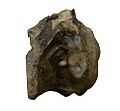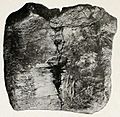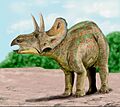List of North American dinosaurs facts for kids
North America is a fantastic place to find dinosaur fossils! Many different kinds of dinosaurs once roamed this continent. This article lists the dinosaurs whose remains have been discovered here.
Contents
Dinosaur Discoveries in North America
The story of dinosaurs in North America began a very long time ago.
Early Dinosaurs: Triassic Period
The very first hints of dinosaurs in North America are rare footprints found in North Carolina. These footprints are from the Middle to Late Triassic Period. More definite dinosaur fossils from the Late Triassic have been found in Texas. These early finds include dinosaurs like Coelophysis, Chindesaurus, Gojirasaurus, and Tawa. Interestingly, dinosaurs similar to Tawa have also been found in South America. This tells us important things about how the continents were connected long ago.
Jurassic Giants: Early and Late Jurassic Periods
During the Early Jurassic Period, new dinosaurs appeared. These included Dilophosaurus, Anchisaurus, and Scutellosaurus. Scutellosaurus was an early armored dinosaur, believed to be an ancestor of all stegosaurs and ankylosaurs.
The Middle Jurassic is a bit of a mystery in North America, as not many complete dinosaur fossils from this time have been found. However, the Late Jurassic Period was the complete opposite! The Morrison Formation is a famous fossil site found across several U.S. states like Colorado, Utah, and Wyoming. It's one of the best places in the world to find dinosaur fossils!
Many amazing dinosaurs lived here during the Late Jurassic:
- Meat-eaters (Theropods): Allosaurus, Torvosaurus, Ceratosaurus, and smaller ones like Coelurus and Ornitholestes.
- Long-necked plant-eaters (Sauropods): A huge variety, including Apatosaurus, Diplodocus, Brachiosaurus, Camarasaurus, and Brontosaurus.
- Armored dinosaurs (Stegosaurs): Stegosaurus with its famous plates and tail spikes.
- Other plant-eaters (Ornithopods): Camptosaurus and Dryosaurus.
Cretaceous Creatures: Early and Late Cretaceous Periods
In the Early Cretaceous Period, many new types of dinosaurs evolved. Sauropods were still around, but they weren't as common as before.
- Meat-eaters: Fast and fierce raptors like Deinonychus and Utahraptor, and the giant Acrocanthosaurus.
- Long-necked plant-eaters: Huge sauropods such as Astrodon and Sauroposeidon.
- Armored dinosaurs: Ankylosaurs like Sauropelta and Gastonia took over from their stegosaur cousins.
- Other plant-eaters: Tenontosaurus and Protohadros were common.
- Strange new dinosaurs: Falcarius, a type of therizinosaur, also lived here. They had long claws and were plant-eaters.
The Late Cretaceous Period saw even more dinosaur diversity!
- Hadrosaurs: Duck-billed dinosaurs like Eolambia became very common.
- Tyrannosaurs: Smaller ones like Moros intrepidus appeared first, eventually leading to the giant predators.
- Horned dinosaurs (Ceratopsians): Zuniceratops was an early horned dinosaur. Later, during the Campanian stage, there was an amazing variety, including Pachyrhinosaurus, Styracosaurus, Centrosaurus, and Pentaceratops.
- Duck-billed dinosaurs: Many different hadrosaurs thrived, such as Hypacrosaurus, Gryposaurus, Parasaurolophus, and Corythosaurus.
- Tyrannosaurs: Large predators like Albertosaurus, Gorgosaurus, and Daspletosaurus ruled.
- Raptors: Dromaeosaurus and Saurornitholestes were still hunting.
- Armored dinosaurs: Ankylosaurus and Edmontonia were heavily armored plant-eaters.
- Dome-headed dinosaurs (Pachycephalosaurs): Pachycephalosaurus with its thick skull dome.
- The very last dinosaurs: In the final years of the Cretaceous, just before the big extinction event, dinosaurs like the giant Alamosaurus (a sauropod), Triceratops (a famous horned dinosaur), and the mighty Tyrannosaurus roamed North America.
Dinosaurs in Central America
Finding dinosaur fossils in Central America is much rarer. Only one definite dinosaur bone has been found in Honduras. It was a leg bone from a small duck-billed dinosaur or iguanodontid, discovered in 1971. An older newspaper story from 1933 mentioned other bones found in Honduras, but these have since been lost.
What Makes a Dinosaur Part of This List?
For a dinosaur to be included in this list, it needs to meet a few rules:
- The dinosaur's name must be officially recognized on the List of dinosaur genera.
- At least one species of that dinosaur must have been found in North America.
- This list adds to the information found in Category:Mesozoic dinosaurs of North America.
List of North American Dinosaurs
Valid Genera
| Name | Year | Formation | Location | Notes | Images |
|---|---|---|---|---|---|
| Abydosaurus | 2010 | Cedar Mountain Formation (Early Cretaceous, Albian) | ( |
Had a short domed crest on its skull similar to that of Giraffatitan | 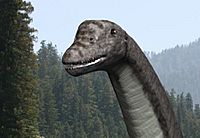 |
| Acantholipan | 2018 | Pen Formation (Late Cretaceous, Santonian) | ( |
Known to possess spike-like osteoderms | 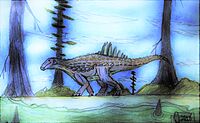 |
| Achelousaurus | 1994 | Two Medicine Formation (Late Cretaceous, Campanian) | ( |
Combines long spikes on the top of its frill and a low keratinous boss over its eyes and nose |  |
| Acheroraptor | 2013 | Hell Creek Formation (Late Cretaceous, Maastrichtian) | ( |
One of the geologically youngest dromaeosaurids |  |
| Acristavus | 2011 | Two Medicine Formation, Wahweap Formation (Late Cretaceous, Campanian) | ( |
Uniquely for a hadrosaurid, it lacked any ornamentation on its skull | 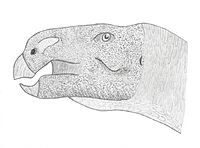 |
| Acrocanthosaurus | 1950 | Antlers Formation, Arundel Formation, Cloverly Formation, Twin Mountains Formation (Early Cretaceous, Aptian to Albian) | ( |
Possessed elongated neural spines that would have supported a low sail or hump in life |  |
| Acrotholus | 2013 | Milk River Formation (Late Cretaceous, Santonian) | ( |
Had a tall, oval-shaped dome | 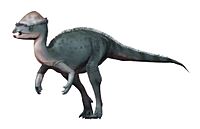 |
| Adelolophus | 2014 | Wahweap Formation (Late Cretaceous, Campanian) | ( |
Potentially a close relative of Parasaurolophus | 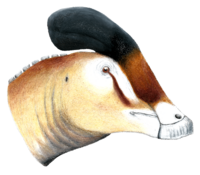 |
| Agujaceratops | 2006 | Aguja Formation (Late Cretaceous, Campanian) | ( |
The type species was originally assigned to the genus Chasmosaurus | 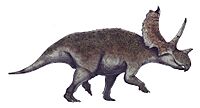 |
| Ahshislepelta | 2011 | Kirtland Formation (Late Cretaceous, Campanian) | ( |
Relatively small compared to other North American ankylosaurs | 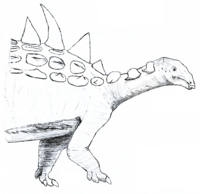 |
| Akainacephalus | 2018 | Kaiparowits Formation (Late Cretaceous, Campanian) | ( |
Much of the skeleton is known, including the entirety of the skull |  |
| Alamosaurus | 1922 | Black Peaks Formation, El Picacho Formation, Evanston Formation?, Javelina Formation, North Horn Formation, Ojo Alamo Formation (Late Cretaceous, Maastrichtian) | ( |
The only titanosaur confirmed to have crossed into North America. One of the largest dinosaurs known from the continent | 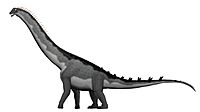 |
| Alaskacephale | 2006 | Prince Creek Formation (Late Cretaceous, Maastrichtian) | ( |
Had an array of polygonal nodes on its squamosal | 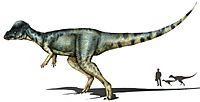 |
| Albertaceratops | 2007 | Oldman Formation (Late Cretaceous, Campanian) | ( |
Possessed long brow horns and a bony ridge over its nose | 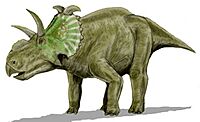 |
| Albertadromeus | 2013 | Oldman Formation (Late Cretaceous, Campanian) | ( |
The proportions of its hindlimb suggest a cursorial lifestyle |  |
| Albertavenator | 2017 | Horseshoe Canyon Formation (Late Cretaceous, Maastrichtian) | ( |
Its discovery suggests the diversity of small dinosaurs may be higher than previously thought | 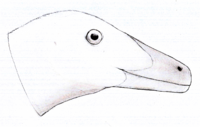 |
| Albertonykus | 2009 | Horseshoe Canyon Formation (Late Cretaceous, Maastrichtian) | ( |
May have used its specialized forelimbs to dig into tree trunks for termites |  |
| Albertosaurus | 1905 | Horseshoe Canyon Formation (Late Cretaceous, Maastrichtian) | ( |
Known from more than thirty specimens, twenty-six of which are preserved together | 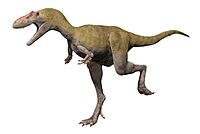 |
| Aletopelta | 2001 | Point Loma Formation (Late Cretaceous, Campanian) | ( |
Would have lived in present-day Mexico; its fossils were only found in California due to the shifting of tectonic plates | 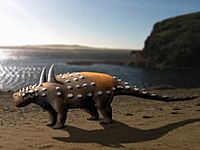 |
| Allosaurus | 1877 | Morrison Formation (Late Jurassic, Kimmeridgian to Tithonian) | ( |
Multiple specimens have been discovered, making it well-known both popularly and scientifically. At least two species are known from the United States, with a third described from Portugal |  |
| Ampelognathus | 2023 | Lewisville Formation (Late Cretaceous, Cenomanian) | ( |
More closely related to iguanodonts than to the morphologically similar "hypsilophodonts" |  |
| Amphicoelias | 1878 | Morrison Formation (Late Jurassic, Tithonian) | ( |
Originally believed to date from the Cretaceous | 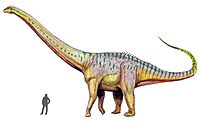 |
| Anasazisaurus | 1993 | Kirtland Formation (Late Cretaceous, Campanian) | ( |
May have been a second species of Kritosaurus |  |
| Anchiceratops | 1914 | Horseshoe Canyon Formation (Late Cretaceous, Campanian) | ( |
Had a long, rectangular frill ringed by short, triangular spikes | 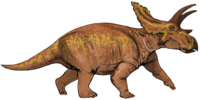 |
| Anchisaurus | 1885 | Portland Formation (Early Jurassic, Hettangian to Sinemurian) | ( |
Some possible remains were originally misidentified as human skeletons | 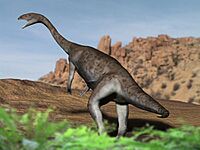 |
| Angulomastacator | 2009 | Aguja Formation (Late Cretaceous, Campanian) | ( |
The tip of its jaw was angled 45 degrees downward, with the tooth row bent to match | 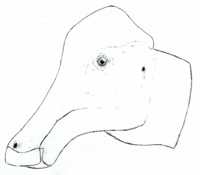 |
| Animantarx | 1999 | Cedar Mountain Formation (Early Cretaceous to Late Cretaceous, Albian to Cenomanian) | ( |
Its holotype was discovered during a radiological survey of a fossil site; no bones were exposed before it was excavated |  |
| Ankylosaurus | 1908 | Ferris Formation, Frenchman Formation, Hell Creek Formation, Lance Formation, Scollard Formation (Late Cretaceous, Maastrichtian) | ( ( |
The largest and most well-known ankylosaur |  |
| Anodontosaurus | 1929 | Horseshoe Canyon Formation (Late Cretaceous, Campanian to Maastrichtian) | ( |
Originally mistakenly believed to have been toothless |  |
| Anzu | 2014 | Hell Creek Formation (Late Cretaceous, Maastrichtian) | ( |
Large and known from considerably good remains. Preserves evidence of a tall head crest | 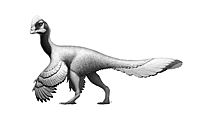 |
| Apatoraptor | 2016 | Horseshoe Canyon Formation (Late Cretaceous, Campanian) | ( |
Quill knobs preserved on its ulna confirm this species had wings | 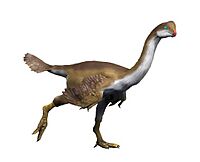 |
| Apatosaurus | 1877 | Morrison Formation (Late Jurassic, Kimmeridgian to Tithonian) | ( |
Had a characteristically robust skeleton compared to other diplodocids |  |
| Appalachiosaurus | 2005 | Demopolis Chalk, Donoho Creek Formation?, Tar Heel Formation? (Late Cretaceous, Campanian) | ( |
The most complete theropod known from the eastern side of North America |  |
| Aquilarhinus | 2019 | Aguja Formation (Late Cretaceous, Campanian) | ( |
May have been a semiaquatic, coastal species that used its unusual, shovel-shaped bill to scoop up vegetation in wet sediment | 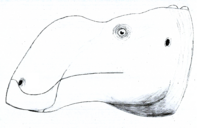 |
| Aquilops | 2014 | Cloverly Formation (Early Cretaceous, Albian) | ( |
May have had a short horn protruding from its upper beak | 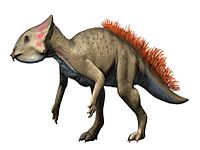 |
| Arkansaurus | 2018 | Trinity Group (Early Cretaceous, Aptian to Albian) | ( |
State dinosaur of Arkansas. Its generic name was in use informally even before its formal description | 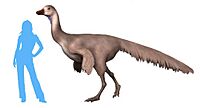 |
| Arrhinoceratops | 1925 | Horseshoe Canyon Formation (Late Cretaceous, Campanian to Maastrichtian) | ( |
Described as lacking a nasal horn although this is an artifact of preservation | 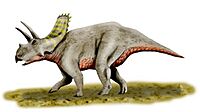 |
| Astrodon | 1859 | Antlers Formation?, Arundel Formation (Early Cretaceous, Albian) | ( |
State dinosaur of Maryland |  |
| Astrophocaudia | 2012 | Trinity Group (Early Cretaceous, Albian) | ( |
Known from a single partial skeleton | 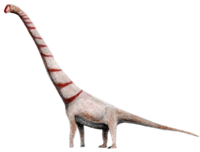 |
| Atlantosaurus | 1877 | Morrison Formation (Late Jurassic, Kimmeridgian) | ( |
Potentially synonymous with Apatosaurus, but a referred species may represent a separate taxon |  |
| Atrociraptor | 2004 | Horseshoe Canyon Formation (Late Cretaceous, Maastrichtian) | ( |
Had a short, deep snout with enlarged teeth |  |
| Aublysodon | 1868 | Judith River Formation (Late Cretaceous, Campanian) | ( |
Only known from teeth |  |
| Augustynolophus | 2014 | Moreno Formation (Late Cretaceous, Maastrichtian) | ( |
State dinosaur of California. Originally named as a species of Saurolophus |  |
| Avaceratops | 1986 | Judith River Formation (Late Cretaceous, Campanian) | ( |
Lacked the fenestrae in its frill, a feature shared only with Triceratops |  |
| Bambiraptor | 2000 | Two Medicine Formation (Late Cretaceous, Campanian) | ( |
Small but well-preserved enough to display its mix of dinosaur- and bird-like features |  |
| Barosaurus | 1890 | Morrison Formation (Late Jurassic, Tithonian) | ( |
Similar to Diplodocus but larger and with a longer neck |  |
| Bistahieversor | 2010 | Fruitland Formation, Kirtland Formation (Late Cretaceous, Campanian) | ( |
Analysis of its braincase suggest it behaved like tyrannosaurids despite not being a member of that family |  |
| Bisticeratops | 2022 | Kirtland Formation (Late Cretaceous, Campanian) | ( |
Preserves bite marks from a tyrannosaurid | 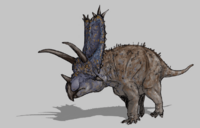 |
| Borealopelta | 2017 | Clearwater Formation (Early Cretaceous, Albian) | ( |
So well preserved that several osteoderms, keratin, pigments, and stomach contents are preserved in the positions they would been in while alive, without flattening or shriveling |  |
| Boreonykus | 2015 | Wapiti Formation (Late Cretaceous, Campanian) | ( |
One of the few dromaeosaurids known from high latitudes |  |
| Brachiosaurus | 1903 | Morrison Formation (Late Jurassic, Kimmeridgian to Tithonian) | ( |
A high browser with a tall chest and elongated forelimbs | 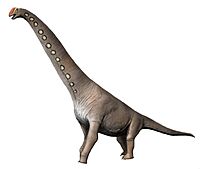 |
| Brachyceratops | 1914 | Two Medicine Formation (Late Cretaceous, Campanian) | ( |
Only known from juvenile remains. One specimen has been found to represent a subadult Styracosaurus ovatus |  |
| Brachylophosaurus | 1953 | Judith River Formation, Oldman Formation, Wahweap Formation? (Late Cretaceous, Campanian) | ( ( |
Several specimens preserve extensive soft tissue remains |  |
| Bravoceratops | 2013 | Javelina Formation (Late Cretaceous, Campanian to Maastrichtian) | ( |
May have had a single small horn on the top of its frill | 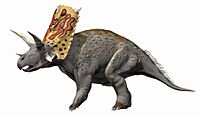 |
| Brontomerus | 2011 | Cedar Mountain Formation (Early Cretaceous, Aptian to Albian) | ( |
Possessed an enlarged ilium which supported powerful leg muscles, which it may have used to kick away predators |  |
| Brontosaurus | 1879 | Morrison Formation (Late Jurassic, Kimmeridgian) | ( |
Popularly associated with Apatosaurus but a 2015 study found enough differences for it to be classified as a separate genus |  |
| Caenagnathus | 1940 | Dinosaur Park Formation (Late Cretaceous, Campanian) | ( |
One of the largest known caenagnathids | 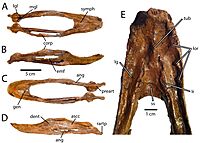 |
| Camarasaurus | 1877 | Morrison Formation, Summerville Formation? (Late Jurassic, Kimmeridgian to Tithonian) | ( |
Very common and known from multiple specimens | 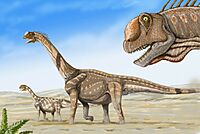 |
| Camposaurus | 1998 | Bluewater Creek Formation (Late Triassic, Norian) | ( |
Potentially the oldest known neotheropod |  |
| Camptosaurus | 1885 | Morrison Formation (Late Jurassic, Oxfordian to Tithonian) | ( |
May have fed on tough vegetation as evidenced by extensive wear frequently exhibited on its teeth | 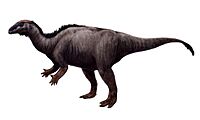 |
| Caseosaurus | 1998 | Dockum Group (Late Triassic, Norian) | ( |
Possibly synonymous with Chindesaurus |  |
| Cedarosaurus | 1999 | Cedar Mountain Formation (Early Cretaceous, Valanginian) | ( |
One specimen preserves over a hundred gastroliths | 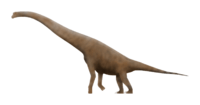 |
| Cedarpelta | 2001 | Cedar Mountain Formation (Late Cretaceous, Cenomanian to Turonian) | ( |
Lacked the extensive cranial ornamentation of later ankylosaurs | 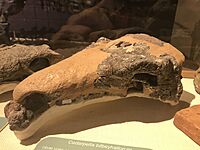 |
| Cedrorestes | 2007 | Cedar Mountain Formation (Early Cretaceous, Valanginian) | ( |
Known from a partial skeleton. The specific name, C. crichtoni, is named after Michael Crichton, author of Jurassic Park | 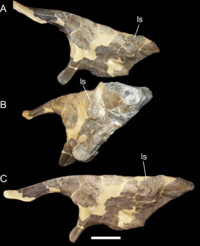 |
| Centrosaurus | 1904 | Dinosaur Park Formation (Late Cretaceous, Campanian) | ( |
Hundreds of individuals have been preserved in a single "mega-bonebed" |  |
| Cerasinops | 2007 | Two Medicine Formation (Late Cretaceous, Campanian) | ( |
Combines features of both Asian and American basal ceratopsians | 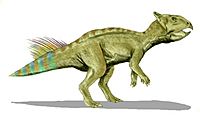 |
| Ceratops | 1888 | Judith River Formation (Late Cretaceous, Campanian) | ( |
Although only known from a few bones, this genus is the namesake of the Ceratopsia and the Ceratopsidae | 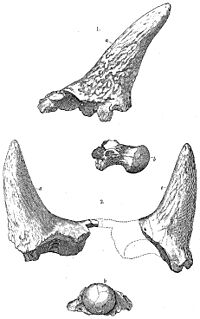 |
| Ceratosaurus | 1884 | Morrison Formation (Late Jurassic, Oxfordian to Tithonian) | ( |
Possessed a row of osteoderms running down its back |  |
| Chasmosaurus | 1914 | Dinosaur Park Formation (Late Cretaceous, Campanian) | ( |
Known from multiple remains, including various skulls | 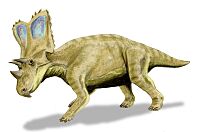 |
| Chindesaurus | 1995 | Chinle Formation (Late Triassic, Norian) | ( |
May be a herrerasaur or a close relative of Tawa | 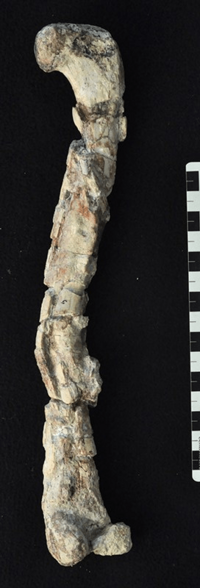 |
| Chirostenotes | 1924 | Dinosaur Park Formation (Late Cretaceous, Campanian) | ( |
Originally known only from isolated body parts | 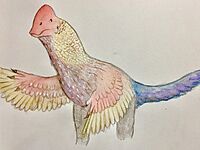 |
| Cionodon | 1874 | Denver Formation, Judith River Formation (Late Cretaceous, Campanian to Maastrichtian) | ( ( |
Poorly known |  |
| Citipes | 2020 | Dinosaur Park Formation (Late Cretaceous, Campanian) | ( |
Some specimens were found as stomach contents of Gorgosaurus |  |
| Claosaurus | 1890 | Niobrara Formation (Late Cretaceous, Santonian to Campanian) | ( |
Historically conflated with other hadrosaurs | 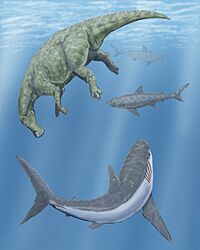 |
| Coahuilaceratops | 2010 | Cerro del Pueblo Formation (Late Cretaceous, Campanian) | ( |
Possessed the longest brow horns of any ceratopsian | 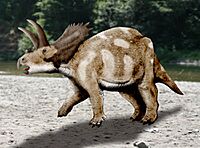 |
| Coelophysis | 1889 | Chinle Formation (Late Triassic, Carnian to Rhaetian) | ( |
Known from over a thousand specimens, making it one of the more well-known early dinosaurs. Some referred species may belong to their own genera | 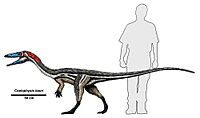 |
| Coelurus | 1879 | Morrison Formation (Late Jurassic, Kimmeridgian) | ( |
Potentially an early member of the tyrannosauroid lineage |  |
| Colepiocephale | 2003 | Foremost Formation (Late Cretaceous, Campanian) | ( |
Originally described as a species of Stegoceras |  |
| Convolosaurus | 2019 | Twin Mountains Formation (Early Cretaceous, Aptian) | ( |
Before its formal description, it had been informally referred to as the "Proctor Lake hypsilophodont" | 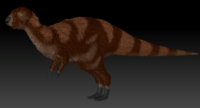 |
| Coronosaurus | 2012 | Oldman Formation (Late Cretaceous, Campanian) | ( |
Had irregular masses of small spikes on the very top of its frill |  |
| Corythosaurus | 1914 | Dinosaur Park Formation, Oldman Formation (Late Cretaceous, Campanian) | ( |
Possessed a semicircular crest which may have been used for vocalization |  |
| Crittendenceratops | 2018 | Fort Crittenden Formation (Late Cretaceous, Campanian) | ( |
The youngest known member of the Nasutoceratopsini |  |
| Daemonosaurus | 2011 | Chinle Formation (Late Triassic, Rhaetian) | ( |
Unique among early dinosaurs for possessing a short snout with long teeth | 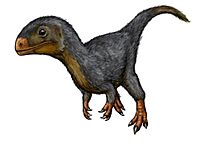 |
| Dakotadon | 2008 | Lakota Formation (Early Cretaceous, Barremian) | ( |
Originally named as a species of Iguanodon | 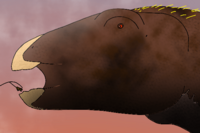 |
| Dakotaraptor | 2015 | Hell Creek Formation (Late Cretaceous, Maastrichtian) | ( |
The holotype assemblage may represent a chimera of multiple taxa | 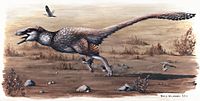 |
| Daspletosaurus | 1970 | Dinosaur Park Formation, Judith River Formation, Oldman Formation, Two Medicine Formation (Late Cretaceous, Campanian) | ( ( |
At least three species are known. These have been interpreted as forming an anagenetic lineage but this hypothesis has been criticized |  |
| Deinonychus | 1969 | Antlers Formation, Arundel Formation?, Cedar Mountain Formation?, Cloverly Formation (Early Cretaceous, Aptian to Albian) | ( |
Its discovery helped researchers realize that dinosaurs were active, warm-blooded animals, kicking off the Dinosaur Renaissance |  |
| Denversaurus | 1988 | Lance Formation (Late Cretaceous, Maastrichtian) | ( |
The youngest known nodosaurid |  |
| Diabloceratops | 2010 | Wahweap Formation (Late Cretaceous, Campanian) | ( |
Had a distinctively short and deep skull | 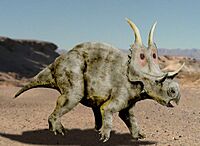 |
| Diclonius | 1876 | Judith River Formation (Late Cretaceous, Campanian) | ( |
Replaced its teeth in such a way that new teeth could be used at the same time as older ones | |
| Dilophosaurus | 1970 | Kayenta Formation (Early Jurassic, Sinemurian to Pliensbachian) | ( |
Possessed two semicircular crests running along the length of the skull |  |
| Dineobellator | 2020 | Ojo Alamo Formation (Late Cretaceous, Maastrichtian) | ( |
Several features of its hands and feet may be adaptations for increased grip strength |  |
| Diplodocus | 1878 | Morrison Formation (Late Jurassic, Kimmeridgian) | ( |
Had a long, thin tail. Popularly thought to have been used like a bullwhip but it is possible that it could not handle the stress of supersonic travel |  |
| Diplotomodon | 1868 | Hornerstown Formation?/Navesink Formation? (Late Cretaceous, Maastrichtian) | ( |
Has been suggested to be non-dinosaurian |  |
| Dromaeosaurus | 1922 | Dinosaur Park Formation (Late Cretaceous, Campanian to Maastrichtian) | ( |
Analysis of wear on its teeth suggest it preferred tougher prey, including bone |  |
| Dromiceiomimus | 1972 | Horseshoe Canyon Formation (Late Cretaceous, Maastrichtian) | ( |
May be synonymous with Ornithomimus edmontonicus | 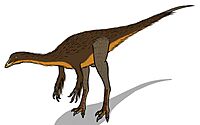 |
| Dryosaurus | 1894 | Morrison Formation (Late Jurassic, Kimmeridgian to Tithonian) | ( |
Remains of multiple growth stages have been found, including embryoes | 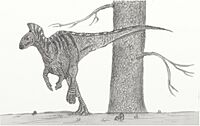 |
| Dryptosaurus | 1877 | Hornerstown Formation?/New Egypt Formation? (Late Cretaceous, Maastrichtian) | ( |
Its discovery showed that theropods were bipedal animals |  |
| Dynamoterror | 2018 | Menefee Formation (Late Cretaceous, Campanian) | ( |
Part of the Teratophoneini, a clade of exclusively southwestern American tyrannosaurs |  |
| Dyoplosaurus | 1924 | Dinosaur Park Formation (Late Cretaceous, Campanian) | ( |
The holotype specimen preserves skin impressions |  |
| Dysganus | 1876 | Judith River Formation (Late Cretaceous, Campanian) | ( |
Four species have been named, all from isolated teeth | |
| Dyslocosaurus | 1992 | Lance Formation?/Morrison Formation? (Late Jurassic, Kimmeridgian?/Late Cretaceous, Maastrichtian?) | ( |
Has been suggested to have four claws on its hind limbs |  |
| Dystrophaeus | 1877 | Morrison Formation (Late Jurassic, Oxfordian) | ( |
Inconsistent in phylogenetic placement, although undescribed remains could further clarify its relationships | 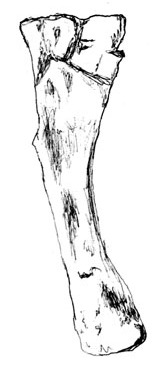 |
| Edmontonia | 1928 | Dinosaur Park Formation, Horseshoe Canyon Formation, Judith River Formation? (Late Cretaceous, Campanian to Maastrichtian) | ( ( |
Possessed forward-pointing, bifurcated spikes on its shoulders |  |
| Edmontosaurus | 1917 | Frenchman Formation, Hell Creek Formation, Horseshoe Canyon Formation, Lance Formation, Prince Creek Formation (Late Cretaceous, Campanian to Maastrichtian) | ( ( |
Known from multiple well-preserved specimens, including a few "mummies". Several were originally assigned to their own genera and/or species |  |
| Einiosaurus | 1994 | Two Medicine Formation (Late Cretaceous, Campanian) | ( |
Distinguished by its forward-curving nasal horn | 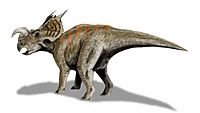 |
| Eolambia | 1998 | Cedar Mountain Formation (Late Cretaceous, Cenomanian) | ( |
Remains of multiple individuals are known, making up much of the skeleton | 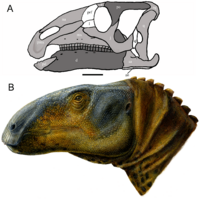 |
| Eotrachodon | 2016 | Mooreville Chalk (Late Cretaceous, Santonian) | ( |
Had a saurolophine-like skull despite its basal position | 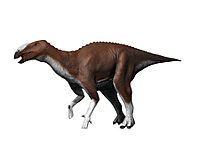 |
| Eotriceratops | 2007 | Horseshoe Canyon Formation (Late Cretaceous, Maastrichtian) | ( |
May have been the largest known ceratopsid | 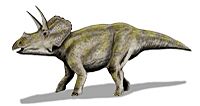 |
| Epichirostenotes | 2011 | Horseshoe Canyon Formation (Late Cretaceous, Maastrichtian) | ( |
Its discovery allowed researchers to connect isolated caenagnathid body parts to each other | 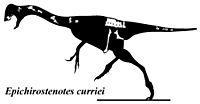 |
| Euoplocephalus | 1910 | Dinosaur Park Formation (Late Cretaceous, Campanian) | ( |
Unusually, its palpebral bone was mobile, allowing it to be used as an eyelid |  |
| Falcarius | 2005 | Cedar Mountain Formation (Early Cretaceous, Valanginian) | ( |
Transitional between generalized theropods and specialized therizinosaurs |  |
| Ferrisaurus | 2019 | Tango Creek Formation (Late Cretaceous, Maastrichtian) | ( |
Its holotype was discovered close to a railway line |  |
| Foraminacephale | 2016 | Dinosaur Park Formation, Oldman Formation (Late Cretaceous, Campanian) | ( |
Originally assigned to three different pachycephalosaurid genera |  |
| Fosterovenator | 2014 | Morrison Formation (Late Jurassic, Oxfordian to Tithonian) | ( |
Has been variously described as a ceratosaurid, a tetanuran, or a close relative of Elaphrosaurus |  |
| Fruitadens | 2010 | Morrison Formation (Late Jurassic, Tithonian) | ( |
One of the smallest known ornithischians |  |
| Furcatoceratops | 2023 | Judith River Formation (Late Cretaceous, Campanian) | ( |
Preserves most of the postcranial skeleton, a rarity for ceratopsids. Remains originally identified as Avaceratops |  |
| Galeamopus | 2015 | Morrison Formation (Late Jurassic, Kimmeridgian) | ( |
One specimen is nearly complete, even preserving an associated skull |  |
| Gargoyleosaurus | 1998 | Morrison Formation (Late Jurassic, Kimmeridgian to Tithonian) | ( |
Combines features of both ankylosaurids and nodosaurids | 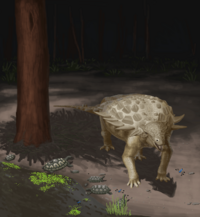 |
| Gastonia | 1998 | Cedar Mountain Formation (Early Cretaceous, Valanginian) | ( |
Several concentrations of fossils may suggest this taxon lived in herds |  |
| Geminiraptor | 2010 | Cedar Mountain Formation (Early Cretaceous, Valanginian) | ( |
The proportions of its maxilla are similar to those of Late Cretaceous troodontids | 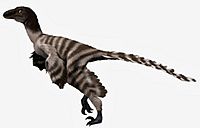 |
| Glishades | 2010 | Two Medicine Formation (Late Cretaceous, Campanian) | ( |
Described as a basal hadrosauroid but may in fact be a juvenile saurolophine hadrosaurid | |
| Glyptodontopelta | 2000 | Ojo Alamo Formation (Late Cretaceous, Campanian to Maastrichtian) | ( |
Originally interpreted as possessing a flat mosaic of osteoderms similar to the shields of glyptodonts |  |
| Gojirasaurus | 1997 | Dockum Group (Late Triassic, Norian) | ( |
May be a chimera consisting of undiagnostic theropod bones mixed with pseudosuchian vertebrae |  |
| Gorgosaurus | 1914 | Dinosaur Park Formation, Judith River Formation?, Two Medicine Formation? (Late Cretaceous, Campanian) | ( ( |
Dozens of specimens are known |  |
| Gravitholus | 1979 | Dinosaur Park Formation (Late Cretaceous, Campanian) | ( |
Potentially synonymous with Stegoceras | 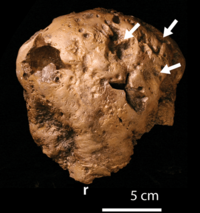 |
| Gremlin | 2023 | Oldman Formation (Late Cretaceous, Campanian) | ( |
Possessed a ridge running along the top of the skull |  |
| Gryphoceratops | 2012 | Milk River Formation (Late Cretaceous, Santonian) | ( |
Potentially the smallest adult ceratopsian known from North America |  |
| Gryposaurus | 1914 | Bearpaw Formation?, Dinosaur Park Formation, Javelina Formation?, Kaiparowits Formation, Two Medicine Formation (Late Cretaceous, Santonian to Maastrichtian) | ( ( |
One specimen preserves impressions of a row of pyramidal scales running along its back |  |
| Hadrosaurus | 1858 | Woodbury Formation (Late Cretaceous, Campanian) | ( |
Its holotype was the first dinosaur skeleton to be mounted |  |
| Hagryphus | 2005 | Kaiparowits Formation (Late Cretaceous, Campanian) | ( |
Large but only known from a single hand |  |
| Hanssuesia | 2003 | Dinosaur Park Formation, Judith River Formation, Oldman Formation (Late Cretaceous, Campanian) | ( ( |
One dome preserves several lesions |  |
| Haplocanthosaurus | 1903 | Morrison Formation (Late Jurassic, Kimmeridgian) | ( |
One of the smallest sauropods of the Morrison Formation |  |
| Hesperonychus | 2009 | Dinosaur Park Formation (Late Cretaceous, Campanian) | ( |
A common component of its habitat as indicated by the great number of its remains |  |
| Hesperornithoides | 2019 | Morrison Formation (Late Jurassic, Oxfordian to Tithonian) | ( |
Before its formal description, it had been nicknamed "Lori" | 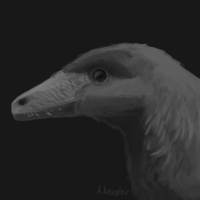 |
| Hesperosaurus | 2001 | Morrison Formation (Late Jurassic, Kimmeridgian) | ( |
Two morphotypes of plates are known, which has been interpreted as an indication of sexual dimorphism | 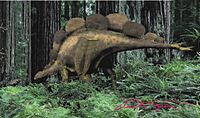 |
| Hierosaurus | 1909 | Niobrara Formation (Late Cretaceous, Coniacian to Campanian) | ( |
Only known from a few bones, including osteoderms | 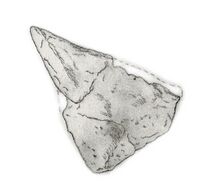 |
| Hippodraco | 2010 | Cedar Mountain Formation (Early Cretaceous, Valanginian) | ( |
Its tooth crowns were shaped like shields |  |
| Hoplitosaurus | 1902 | Lakota Formation (Early Cretaceous, Barremian) | ( |
Known from some osteoderms, including spikes, similar to those of Polacanthus | 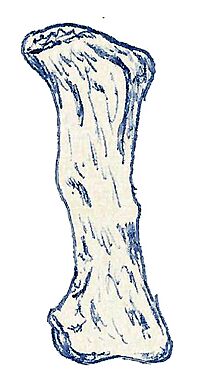 |
| Huehuecanauhtlus | 2012 | Unnamed formation (Late Cretaceous, Santonian) | ( |
The southernmost non-hadrosaurid hadrosauroid known from North America |  |
| Hypacrosaurus | 1913 | Horseshoe Canyon Formation, Two Medicine Formation (Late Cretaceous, Campanian to Maastrichtian) | ( ( |
Some juveniles of this genus were originally interpreted as dwarf lambeosaurines |  |
| Hypsibema | 1869 | Black Creek Group, Ripley Formation (Late Cretaceous, Campanian) | ( |
Potentially one of the largest non-hadrosaurid hadrosauroids | 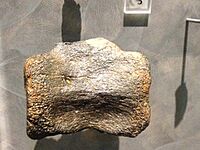 |
| Hypsirhophus | 1878 | Morrison Formation (Late Jurassic, Tithonian) | ( |
Usually seen as synonymous with Stegosaurus but may be a separate genus due to differences in its vertebrae |  |
| Iani | 2023 | Cedar Mountain Formation (Late Cretaceous, Cenomanian) | ( |
It and possibly Tenontosaurus represent the only known rhabdodontomorphs from North America |  |
| Iguanacolossus | 2010 | Cedar Mountain Formation (Early Cretaceous, Valanginian) | ( |
Large and robustly built |  |
| Invictarx | 2018 | Menefee Formation (Late Cretaceous, Campanian) | ( |
Only known from a few bones but can be distinguished from other genera by characters of its osteoderms |  |
| Issi | 2021 | Fleming Fjord Formation (Late Triassic, Norian) | (Sermersooq) |
Originally described as an exemplar of Plateosaurus | 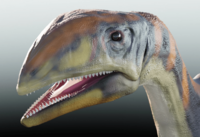 |
| Jeyawati | 2010 | Moreno Hill Formation (Late Cretaceous, Turonian) | ( |
Its postorbital bone had a rugose texture |  |
| Judiceratops | 2013 | Judith River Formation (Late Cretaceous, Campanian) | ( |
Unusually, its brow horns were teardrop-shaped in cross-section | 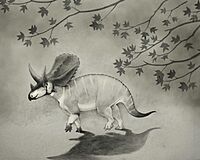 |
| Kaatedocus | 2012 | Morrison Formation (Late Jurassic, Kimmeridgian) | ( |
Originally interpreted as a diplodocid although study finds it to be more likely a basal dicraeosaurid |  |
| Kayentavenator | 2010 | Kayenta Formation (Early Jurassic, Sinemurian to Pliensbachian) | ( |
Described in a book published through an online print-on-demand service | 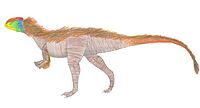 |
| Koparion | 1994 | Morrison Formation (Late Jurassic, Kimmeridgian) | ( |
Known from a single tooth which may have come from a troodontid | 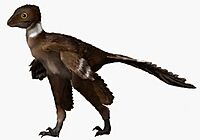 |
| Kosmoceratops | 2010 | Kaiparowits Formation (Late Cretaceous, Campanian) | ( |
Possessed fifteen horns and horn-like structures, including eight hornlets folding down from the top of the frill | 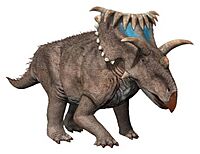 |
| Kritosaurus | 1910 | El Picacho Formation?, Javelina Formation?, Kirtland Formation, Ojo Alamo Formation? (Late Cretaceous, Campanian) | ( |
Had an elevated nasal bone with an enlarged nasal cavity to match |  |
| Labocania | 1974 | La Bocana Roja Formation (Late Cretaceous, Campanian) | ( |
Robustly built with particularly strengthened frontals |  |
| Lambeosaurus | 1923 | Dinosaur Park Formation (Late Cretaceous, Campanian) | ( |
Possessed a hollow head crest that varied in shape between species, sexes, and ages. Most familiarly, it was hatchet-shaped in adult male L. lambei | 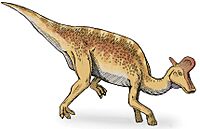 |
| Laosaurus | 1878 | Morrison Formation (Late Jurassic, Oxfordian to Tithonian) | ( |
Several referred specimens have been reassigned to other taxa |  |
| Latirhinus | 2012 | Cerro del Pueblo Formation (Late Cretaceous, Campanian) | ( |
As described, it represented a chimera composed of lambeosaurine and saurolophine remains; the exact holotypic bones belonged to a lambeosaurine |  |
| Lepidus | 2015 | Dockum Group (Late Triassic, Norian) | ( |
Muscle scars are preserved on the holotype bones |  |
| Leptoceratops | 1914 | Hell Creek Formation, Lance Formation, Scollard Formation (Late Cretaceous, Maastrichtian) | ( ( |
Analysis of its teeth show it could chew like a mammal, an adaptation to eating tough, fibrous plants |  |
| Leptorhynchos | 2013 | Aguja Formation (Late Cretaceous, Campanian to Maastrichtian) | ( |
Had a slightly upturned mandible similar to those of oviraptorids | 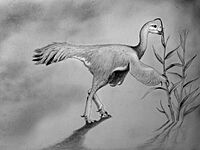 |
| Lophorhothon | 1960 | Black Creek Formation?, Mooreville Chalk (Late Cretaceous, Campanian) | ( |
Although incomplete, the holotype skull preserves evidence of a crest |  |
| Lythronax | 2013 | Wahweap Formation (Late Cretaceous, Campanian) | ( |
Already had the forward-directed orbits of derived tyrannosaurids despite its early age |  |
| Machairoceratops | 2016 | Wahweap Formation (Late Cretaceous, Campanian) | ( |
Possessed two long, forward-pointing horns on the top of its frill | 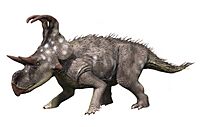 |
| Magnapaulia | 2012 | El Gallo Formation (Late Cretaceous, Campanian) | ( |
Has been suggested to be semi-aquatic due to its tall, narrow tail |  |
| Maiasaura | 1979 | Oldman Formation, Two Medicine Formation (Late Cretaceous, Campanian) | ( ( |
Remains of hundreds of individuals, including juveniles, eggs, and nests, have been found at a single site |  |
| Malefica | 2022 | Aguja Formation (Late Cretaceous, Campanian) | ( |
Its discovery suggests a greater diversity of basal hadrosaurids than previously thought |  |
| Maraapunisaurus | 2018 | Morrison Formation (Late Jurassic, Kimmeridgian) | ( |
Named from a single, lost vertebra of immense size | 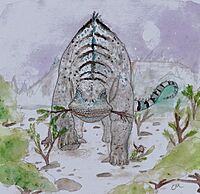 |
| Marshosaurus | 1976 | Morrison Formation (Late Jurassic, Kimmeridgian) | ( |
Potentially a close relative of South American megalosauroids |  |
| Martharaptor | 2012 | Cedar Mountain Formation (Early Cretaceous, Valanginian) | ( |
Had not yet acquired the robust feet of derived therizinosaurs | 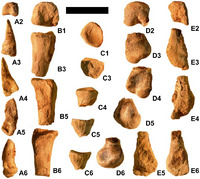 |
| Medusaceratops | 2010 | Judith River Formation (Late Cretaceous, Campanian) | ( |
Possessed elongated spikes curving away from the sides of its frill |  |
| Menefeeceratops | 2021 | Menefee Formation (Late Cretaceous, Campanian) | ( |
One of the oldest centrosaurines |  |
| Mercuriceratops | 2014 | Dinosaur Park Formation, Judith River Formation (Late Cretaceous, Campanian) | ( ( |
Had "wing"-like projections on its squamosal bones | 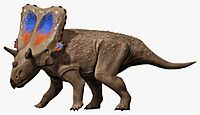 |
| Microvenator | 1970 | Cloverly Formation (Early Cretaceous, Albian) | ( |
Teeth from Deinonychus have been mistakenly attributed to this species | 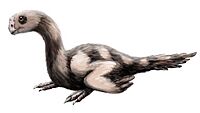 |
| Mierasaurus | 2017 | Cedar Mountain Formation (Early Cretaceous, Valanginian) | ( |
One of the latest-surviving turiasaurs | 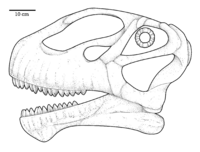 |
| Moabosaurus | 2017 | Cedar Mountain Formation (Early Cretaceous, Aptian) | ( |
Described as a macronarian but has since been reinterpreted as a turiasaur closely related to Mierasaurus |  |
| Monoclonius | 1876 | Dinosaur Park Formation, Judith River Formation (Late Cretaceous, Campanian) | ( ( |
Only known from indistinct remains of juveniles and subadults | 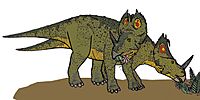 |
| Montanoceratops | 1951 | Horseshoe Canyon Formation?, St. Mary River Formation (Late Cretaceous, Maastrichtian) | ( ( |
Often restored with a short nasal horn although this may be a displaced cheek horn |  |
| Moros | 2019 | Cedar Mountain Formation (Late Cretaceous, Cenomanian) | ( |
The proportions of its metatarsals are similar to those of ornithomimids |  |
| Mymoorapelta | 1994 | Morrison Formation (Late Jurassic, Kimmeridgian to Tithonian) | ( |
The first ankylosaur described from the Morrison Formation |  |
| Naashoibitosaurus | 1993 | Kirtland Formation (Late Cretaceous, Campanian) | ( |
Like other kritosaurins, it possessed a nasal arch, but it was not as tall as that of Gryposaurus |  |
| Nanosaurus | 1877 | Morrison Formation (Late Jurassic, Oxfordian to Tithonian) | ( |
Several referred specimens were originally assigned to other genera |  |
| Nanuqsaurus | 2014 | Prince Creek Formation (Late Cretaceous, Maastrichtian) | ( |
Described as a dwarf tyrannosaurid although undescribed remains suggest a size comparable to Albertosaurus |  |
| Nasutoceratops | 2013 | Kaiparowits Formation (Late Cretaceous, Campanian) | ( |
Possessed an enlarged nasal cavity and two long, curving horns similar to those of modern cattle | 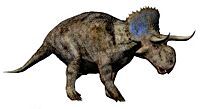 |
| Navajoceratops | 2020 | Kirtland Formation (Late Cretaceous, Campanian) | ( |
Had a distinctive notch at the very top of its frill, similar to its potential ancestor Pentaceratops | 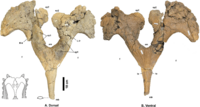 |
| Nedcolbertia | 1998 | Cedar Mountain Formation (Early Cretaceous, Valanginian) | ( |
Known from three partial skeletons. The specific name, N. justinhofmanni, honors a six-year-old schoolboy who won a contest to have a dinosaur named after him |  |
| Nevadadromeus | 2022 | Willow Tank Formation (Late Cretaceous, Cenomanian) | ( |
The first non-avian dinosaur described from Nevada |  |
| Niobrarasaurus | 1995 | Niobrara Formation (Late Cretaceous, Coniacian to Campanian) | ( |
Originally mistakenly believed to have been aquatic | 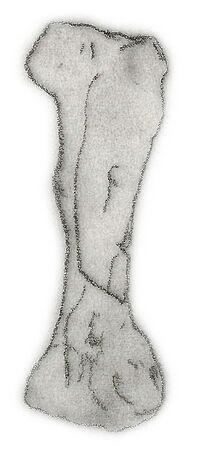 |
| Nodocephalosaurus | 1999 | Kirtland Formation (Late Cretaceous, Campanian to Maastrichtian) | ( |
Closely related to Asian ankylosaurs | |
| Nodosaurus | 1889 | Frontier Formation (Late Cretaceous, Cenomanian to Coniacian) | ( |
Its armor included banded dermal plates interspersed by bony nodules |  |
| Nothronychus | 2001 | Moreno Hill Formation, Tropic Shale (Late Cretaceous, Turonian) | ( |
Would have lived in the marshes and swamps along the Turonian shoreline |  |
| Ojoraptorsaurus | 2011 | Ojo Alamo Formation (Late Cretaceous, Maastrichtian) | ( |
Only known from an incomplete pair of pubes | 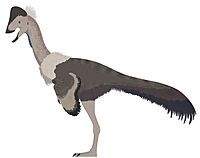 |
| Oohkotokia | 2013 | Two Medicine Formation (Late Cretaceous, Campanian) | ( |
Potentially a synonym of Scolosaurus |  |
| Ornatops | 2021 | Menefee Formation (Late Cretaceous, Campanian) | ( |
Preserves a pair of bumps on its skull which may have anchored a crest |  |
| Ornitholestes | 1903 | Morrison Formation (Late Jurassic, Kimmeridgian) | ( |
May have possessed a sickle claw similar to those of dromaeosaurids |  |
| Ornithomimus | 1890 | Denver Formation, Dinosaur Park Formation, Ferris Formation?, Horseshoe Canyon Formation, Kaiparowits Formation? (Late Cretaceous, Campanian to Maastrichtian) | ( ( |
One referred specimen preserves impressions of ostrich-like feathers covering most of its body | 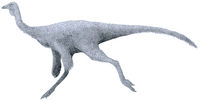 |
| Orodromeus | 1988 | Two Medicine Formation (Late Cretaceous, Campanian) | ( |
Eggs considered to belong to this taxon may have actually come from a troodontid |  |
| Oryctodromeus | 2007 | Blackleaf Formation, Wayan Formation (Late Cretaceous, Cenomanian) | ( |
Several specimens have been preserved in burrows | 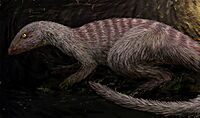 |
| Osmakasaurus | 2011 | Lakota Formation (Early Cretaceous, Valanginian) | ( |
Originally named as a species of Camptosaurus | |
| Pachycephalosaurus | 1943 | Hell Creek Formation, Lance Formation, Scollard Formation? (Late Cretaceous, Maastrichtian) | ( ( |
Possessed a tall, rounded head dome surrounded by bony knobs |  |
| Pachyrhinosaurus | 1950 | Horseshoe Canyon Formation, Prince Creek Formation, St. Mary River Formation, Wapiti Formation (Late Cretaceous, Campanian to Maastrichtian) | ( ( |
Three species have been named, each with a unique pattern of cranial ornamentation |  |
| Palaeoscincus | 1856 | Judith River Formation (Late Cretaceous, Campanian) | ( |
Although many restorations depict it with the spikes of Edmontonia and the tail club of Ankylosaurus, this is most likely incorrect | 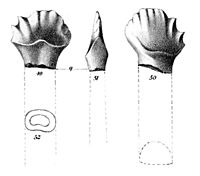 |
| Panoplosaurus | 1919 | Dinosaur Park Formation (Late Cretaceous, Campanian) | ( |
Unlike other nodosaurs, it lacked enlarged spikes |  |
| Parasaurolophus | 1922 | Dinosaur Park Formation, Fruitland Formation, Kaiparowits Formation, Kirtland Formation (Late Cretaceous, Campanian) | ( ( |
Possessed a curved, hollow crest that varied in size between species |  |
| Paraxenisaurus | 2020 | Cerro del Pueblo Formation (Late Cretaceous, Campanian) | ( |
Described as the first deinocheirid from North America |  |
| Parksosaurus | 1937 | Horseshoe Canyon Formation (Late Cretaceous, Maastrichtian) | ( |
Had long toes which may be an adaptation to walking on soft soils in watercourses and marshlands |  |
| Paronychodon | 1876 | Hell Creek Formation, Judith River Formation, Lance Formation (Late Cretaceous, Campanian to Maastrichtian) | ( |
Only known from highly distinctive teeth |  |
| Pawpawsaurus | 1996 | Paw Paw Formation (Early Cretaceous to Late Cretaceous, Albian to Cenomanian) | ( |
Had enlarged nasal cavities that gave it an acute sense of smell, even more powerful than that of contemporary theropods | 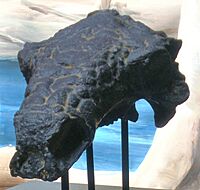 |
| Pectinodon | 1982 | Hell Creek Formation, Lance Formation (Late Cretaceous, Maastrichtian) | ( |
Had comb-like serrations on its teeth |  |
| Peloroplites | 2008 | Cedar Mountain Formation (Late Cretaceous, Cenomanian to Turonian) | ( |
One of the largest known nodosaurids | 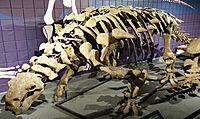 |
| Pentaceratops | 1923 | Fruitland Formation, Kirtland Formation (Late Cretaceous, Campanian) | ( |
Its epijugal bones (the hornlets under its eyes) were relatively large | 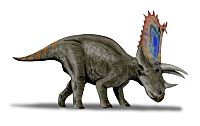 |
| Planicoxa | 2001 | Cedar Mountain Formation (Early Cretaceous, Hauterivian to Albian) | ( |
The rear of its ilium was characteristically flat |  |
| Platypelta | 2018 | Dinosaur Park Formation (Late Cretaceous, Campanian) | ( |
Originally assigned to Euoplocephalus but given its own genus because of several morphological differences | 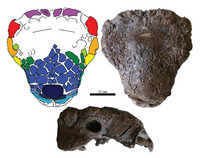 |
| Platytholus | 2023 | Hell Creek Formation (Late Cretaceous, Maastrichtian) | ( |
Differs from juveniles of the contemporary Pachycephalosaurus and Sphaerotholus, hence its separation as a new genus |  |
| Podokesaurus | 1911 | Portland Formation (Early Jurassic, Hettangian to Sinemurian) | ( |
May have had a tail one and a half times longer than the rest of its skeleton |  |
| Polyodontosaurus | 1932 | Dinosaur Park Formation (Late Cretaceous, Campanian) | ( |
May be identical to Latenivenatrix | |
| Polyonax | 1874 | Denver Formation (Late Cretaceous, Maastrichtian) | ( |
Poorly known | |
| Prenoceratops | 2004 | Oldman Formation, Two Medicine Formation (Late Cretaceous, Campanian) | ( ( |
The only basal ceratopsian known from a bonebed | 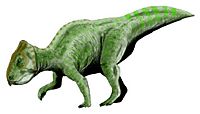 |
| Priconodon | 1888 | Arundel Formation (Early Cretaceous, Aptian to Albian) | ( |
Large but only known from teeth | |
| Probrachylophosaurus | 2015 | Foremost Formation, Judith River Formation (Late Cretaceous, Campanian) | ( ( |
Shows a skull morphology transitional between crestless and crested brachylophosaurins | 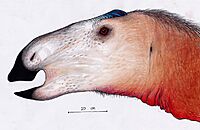 |
| Propanoplosaurus | 2011 | Patuxent Formation (Early Cretaceous, Aptian) | ( |
Only known from the imprints of a neonate skeleton |  |
| Prosaurolophus | 1916 | Dinosaur Park Formation, Two Medicine Formation (Late Cretaceous, Campanian) | ( ( |
Had a relatively large head for a hadrosaur | 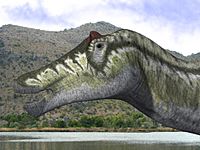 |
| Protohadros | 1998 | Woodbine Formation (Late Cretaceous, Cenomanian) | ( |
Possessed a downturned jaw which may be an adaptation to grazing on low-growing plants | |
| Pteropelyx | 1889 | Judith River Formation (Late Cretaceous, Campanian) | ( |
Potentially synonymous with Corythosaurus, although this cannot be confirmed due to a lack of cranial remains | |
| Rativates | 2016 | Dinosaur Park Formation (Late Cretaceous, Campanian) | ( |
Originally described as a specimen of Struthiomimus | 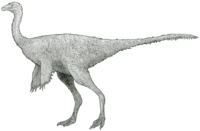 |
| Regaliceratops | 2015 | St. Mary River Formation (Late Cretaceous, Maastrichtian) | ( |
Possessed a series of large, pentagonal plates lining its frill |  |
| Richardoestesia | 1990 | Aguja Formation, Dinosaur Park Formation (Late Cretaceous, Campanian) | ( ( |
Teeth assigned to this genus have been recovered all around the world, in deposits spanning millions of years of time, although they may not represent a single taxon |  |
| Rugocaudia | 2012 | Cloverly Formation (Early Cretaceous, Aptian to Albian) | ( |
Some of this genus' remains include several caudal vertebrae |  |
| Sarahsaurus | 2011 | Kayenta Formation (Early Jurassic, Sinemurian to Pliensbachian) | ( |
Possessed strong hands which may indicate a feeding specialization | 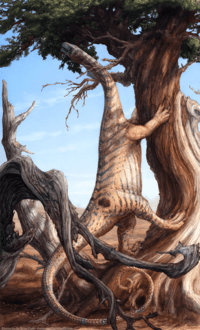 |
| Saurolophus | 1912 | Horseshoe Canyon Formation (Late Cretaceous, Maastrichtian) | ( |
Had a short, solid crest that pointed directly upwards. A larger, more well-known species has been found in Mongolia |  |
| Sauropelta | 1970 | Cedar Mountain Formation?, Cloverly Formation (Early Cretaceous, Albian) | ( |
Its tail had at least forty vertebrae, making up half of its total body length |  |
| Saurophaganax | 1995 | Morrison Formation (Late Jurassic, Kimmeridgian to Tithonian) | ( |
Potentially an extremely large specimen of Allosaurus | 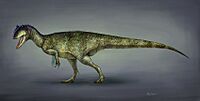 |
| Sauroposeidon | 2000 | Antlers Formation, Glen Rose Formation (Early Cretaceous, Aptian to Albian) | ( |
Could raise its head up to 18 metres (59 ft) in the air, the height of a six-storey building | 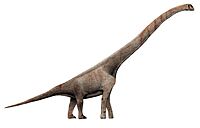 |
| Saurornitholestes | 1978 | Coachman Formation, Dinosaur Park Formation, Donoho Creek Formation, Kirtland Formation, Mooreville Chalk, Oldman Formation, Tar Heel Formation, Two Medicine Formation (Late Cretaceous, Campanian) | ( ( ( |
Its second premaxillary teeth could be adapted to preening feathers | 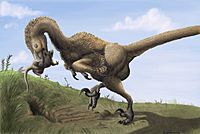 |
| Scolosaurus | 1928 | Dinosaur Park Formation, Oldman Formation (Late Cretaceous, Campanian) | ( |
Once widely believed to be synonymous with other Campanian ankylosaurids |  |
| Scutellosaurus | 1981 | Kayenta Formation (Early Jurassic, Sinemurian) | ( |
Had hundreds of osteoderms arranged in rows along its back and tail |  |
| Segisaurus | 1936 | Navajo Sandstone (Early Jurassic, Pliensbachian to Toarcian) | ( |
Preserves evidence of a wishbone similar to that of modern birds |  |
| Seitaad | 2010 | Navajo Sandstone (Early Jurassic, Pliensbachian) | ( |
The holotype may have died when a sand dune collapsed on it |  |
| Siats | 2013 | Cedar Mountain Formation (Late Cretaceous, Cenomanian) | ( |
Large but inconsistent in phylogenetic placement |  |
| Sierraceratops | 2022 | Hall Lake Formation (Late Cretaceous, Campanian to Maastrichtian) | ( |
May be part of a unique clade of ceratopsians only known from southern Laramidia | 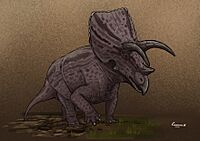 |
| Silvisaurus | 1960 | Dakota Formation (Early Cretaceous to Late Cretaceous, Albian to Cenomanian) | ( |
Hypothesized to live in a forested habitat |  |
| Smitanosaurus | 2020 | Morrison Formation (Late Jurassic, Oxfordian to Tithonian) | ( |
Only known from a partial skull and some vertebrae | 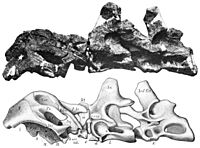 |
| Sonorasaurus | 1998 | Turney Ranch Formation (Early Cretaceous to Late Cretaceous, Albian to Cenomanian) | ( |
State dinosaur of Arizona | 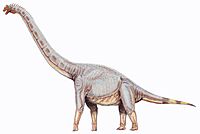 |
| Sphaerotholus | 2002 | Dinosaur Park Formation, Frenchman Formation, Hell Creek Formation, Horseshoe Canyon Formation, Kirtland Formation (Late Cretaceous, Campanian to Maastrichtian) | ( ( |
Five species have been named, all known from skull elements. Lived in a broad range |  |
| Spiclypeus | 2016 | Judith River Formation (Late Cretaceous, Campanian) | ( |
Has been described as "boldly audacious" | 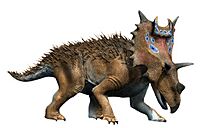 |
| Spinops | 2011 | Dinosaur Park Formation?/Oldman Formation? (Late Cretaceous, Campanian) | ( |
Described almost a century after its remains were collected | 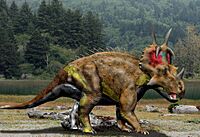 |
| Stegoceras | 1902 | Dinosaur Park Formation, Fruitland Formation?, Kirtland Formation?, Oldman Formation (Late Cretaceous, Campanian) | ( ( |
May have been an indiscriminate bulk-feeder due to the shape of its snout |  |
| Stegopelta | 1905 | Frontier Formation (Early Cretaceous to Late Cretaceous, Albian to Cenomanian) | ( |
May have possessed a sacral shield similar to other nodosaurs |  |
| Stegosaurus | 1877 | Morrison Formation (Late Jurassic, Kimmeridgian to Tithonian) | ( |
Had a single alternating row of large, kite-shaped plates |  |
| Stellasaurus | 2020 | Two Medicine Formation (Late Cretaceous, Campanian) | ( |
Possessed an enlarged, thickened nasal horn | 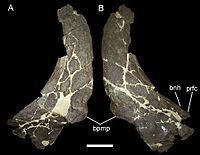 |
| Stenonychosaurus | 1932 | Dinosaur Park Formation, Two Medicine Formation? (Late Cretaceous, Campanian) | ( ( |
Its brain-to-body mass ratio is one of the highest of any non-avian dinosaur's |  |
| Stephanosaurus | 1914 | Dinosaur Park Formation (Late Cretaceous, Campanian) | ( |
Poorly known | 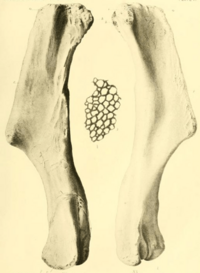 |
| Stokesosaurus | 1974 | Morrison Formation (Late Jurassic, Kimmeridgian to Tithonian) | ( |
Only known from a few remains but they are enough to tell that it was a tyrannosauroid |  |
| Struthiomimus | 1917 | Horseshoe Canyon Formation?, Lance Formation?, Oldman Formation (Late Cretaceous, Campanian to Maastrichtian) | ( ( |
Known from many specimens, indicating it was a common animal | 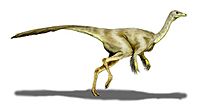 |
| Styracosaurus | 1913 | Dinosaur Park Formation, Two Medicine Formation? (Late Cretaceous, Campanian) | ( ( |
Possessed several long horns jutting out from the top of its frill, the patterns of which could have varied between individuals | 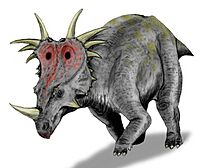 |
| Supersaurus | 1985 | Morrison Formation (Late Jurassic, Tithonian) | ( |
Several remains were originally believed to represent their own genera |  |
| Suskityrannus | 2019 | Moreno Hill Formation (Late Cretaceous, Turonian) | ( |
Small yet already possessed several features of large, derived tyrannosaurids, including an arctometatarsus | 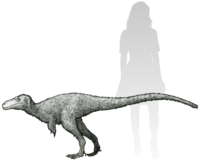 |
| Suuwassea | 2004 | Morrison Formation (Late Jurassic, Oxfordian to Tithonian) | ( |
Shares features with both diplodocids and dicraeosaurids, but is more likely a member of the latter group | |
| Talos | 2011 | Kaiparowits Formation (Late Cretaceous, Campanian) | ( |
The holotype specimen preserves a pathology on its sickle claw |  |
| Tanycolagreus | 2005 | Morrison Formation (Late Jurassic, Oxfordian to Tithonian) | ( |
Had a long, blunt snout |  |
| Tatankacephalus | 2009 | Cloverly Formation (Early Cretaceous, Aptian to Albian) | ( |
Retained premaxillary teeth in its upper jaws, a basal trait | |
| Tawa | 2009 | Chinle Formation (Late Triassic, Norian) | ( |
Well-preserved but inconsistent in phylogenetic placement |  |
| Tenontosaurus | 1970 | Antlers Formation, Arundel Formation, Cedar Mountain Formation, Cloverly Formation, Paluxy Formation, Twin Mountains Formation, Wayan Formation (Early Cretaceous, Aptian to Albian) | ( |
Remains of this genus are often found associated with skeletons of Deinonychus |  |
| Teratophoneus | 2011 | Kaiparowits Formation (Late Cretaceous, Campanian) | ( |
Its snout was shorter and deeper than those of other tyrannosaurids | 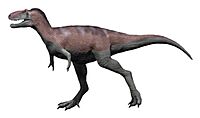 |
| Terminocavus | 2020 | Kirtland Formation (Late Cretaceous, Campanian) | ( |
Had a teardrop-shaped hole on the top of its frill which was almost closed off by a pair of epoccipitals | 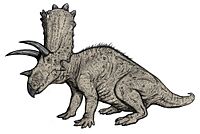 |
| Texacephale | 2010 | Aguja Formation (Late Cretaceous, Campanian) | ( |
Possessed a series of vertical flanges on its dome which may have functioned as "gears" that interlocked when head-butting |  |
| Texasetes | 1995 | Paw Paw Formation (Early Cretaceous, Albian) | ( |
Potentially synonymous with Pawpawsaurus |  |
| Thanatotheristes | 2020 | Foremost Formation (Late Cretaceous, Campanian) | ( |
A close relative of Daspletosaurus |  |
| Theiophytalia | 2006 | Purgatoire Formation (Early Cretaceous, Aptian to Albian) | ( |
Only known from a skull originally referred to Camptosaurus | 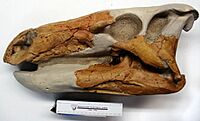 |
| Thescelosaurus | 1913 | Frenchman Formation, Hell Creek Formation, Lance Formation, Laramie Formation, Scollard Formation (Late Cretaceous, Maastrichtian) | ( ( |
One specimen was originally considered to have preserved its heart, although later this was found to be a mineral concretion |  |
| Thespesius | 1856 | Lance Formation (Late Cretaceous, Maastrichtian) | ( |
Once suggested to be a possible Miocene mammal | 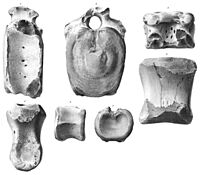 |
| Tichosteus | 1877 | Morrison Formation (Late Jurassic, Kimmeridgian) | ( |
Two species have been named, both from isolated vertebrae | 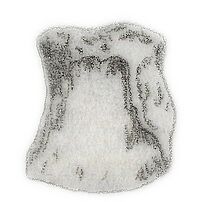 |
| Titanoceratops | 2011 | Fruitland Formation?/Kirtland Formation? (Late Cretaceous, Campanian) | ( |
Potentially a large, old specimen of Pentaceratops |  |
| Tlatolophus | 2021 | Cerro del Pueblo Formation (Late Cretaceous, Campanian) | ( |
Possessed a short, broad crest resembling an inverted comma |  |
| Torosaurus | 1891 | Frenchman Formation, Hell Creek Formation, Lance Formation, Scollard Formation (Late Cretaceous, Maastrichtian) | ( ( |
Once believed to be potentially synonymous with Triceratops |  |
| Torvosaurus | 1979 | Morrison Formation (Middle Jurassic to Late Jurassic, Callovian to Tithonian) | ( |
Had short but powerfully built arms. Several species, many of them unnamed, have been found in Europe, South America, and possibly Africa |  |
| Tototlmimus | 2016 | Packard Formation (Late Cretaceous, Campanian) | ( |
The southernmost ornithomimid known from North America | |
| Trachodon | 1856 | Judith River Formation (Late Cretaceous, Campanian) | ( |
Several remains assigned to this genus actually belong to other taxa, most notably Edmontosaurus |  |
| Triceratops | 1889 | Denver Formation, Evanston Formation, Hell Creek Formation, Lance Formation, Laramie Formation, Scollard Formation (Late Cretaceous, Maastrichtian) | ( ( |
A common ceratopsid with long brow horns and a short nasal horn |  |
| Trierarchuncus | 2020 | Hell Creek Formation (Late Cretaceous, Maastrichtian) | ( |
Known from remains of different sizes which depict how the claws of alvarezsaurids grew more hooked as they aged |  |
| Troodon | 1856 | Judith River Formation, Two Medicine Formation? (Late Cretaceous, Campanian) | ( |
Only known from teeth. Most referred skeletal remains cannot be confidently assigned to this genus |  |
| Tyrannosaurus | 1905 | Frenchman Formation, Hall Lake Formation, Hell Creek Formation, Lance Formation, Willow Creek Formation (Late Cretaceous, Campanian to Maastrichtian) | ( ( |
The last, largest, and most well-known tyrannosaurid |  |
| Unescoceratops | 2012 | Dinosaur Park Formation (Late Cretaceous, Campanian) | ( |
Had the roundest teeth of any known leptoceratopsid | |
| Utahceratops | 2010 | Kaiparowits Formation (Late Cretaceous, Campanian) | ( |
Almost the entire skeleton and skull is known | 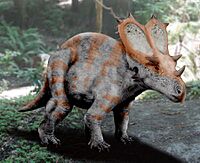 |
| Utahraptor | 1993 | Cedar Mountain Formation (Early Cretaceous, Valanginian to Hauterivian) | ( |
Very large and powerfully built |  |
| Uteodon | 2011 | Morrison Formation (Late Jurassic, Tithonian) | ( |
May be a species of Camptosaurus, with a referred braincase being from Dryosaurus |  |
| Vagaceratops | 2010 | Dinosaur Park Formation (Late Cretaceous, Campanian) | ( |
Possessed a row of fused epoccipitals folding over the top of the frill | 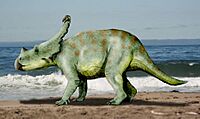 |
| Velafrons | 2007 | Cerro del Pueblo Formation (Late Cretaceous, Campanian) | ( |
May have had elongated neural spines similar to those of Hypacrosaurus altispinus |  |
| Venenosaurus | 2001 | Cedar Mountain Formation (Early Cretaceous, Aptian to Albian) | ( |
Its skeleton has traits of both titanosaurs and more basal macronarians | |
| Wendiceratops | 2015 | Oldman Formation (Late Cretaceous, Campanian) | ( |
Had three pairs of enlarged, curved epiparietals at the very top of its frill |  |
| Xenoceratops | 2012 | Foremost Formation (Late Cretaceous, Campanian) | ( |
Possessed two long spines at the top of its frill with smaller knobs at their bases | 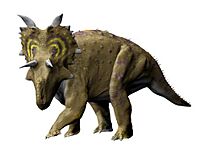 |
| Yehuecauhceratops | 2017 | Aguja Formation (Late Cretaceous, Campanian) | ( |
One of the smallest known ceratopsids | 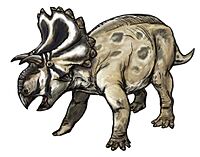 |
| Yurgovuchia | 2012 | Cedar Mountain Formation (Early Cretaceous, Valanginian) | ( |
May have had a flexible tail due to the structure of its caudal vertebrae |  |
| Zapsalis | 1876 | Judith River Formation (Late Cretaceous, Campanian) | ( |
Some teeth referred to this genus actually belong to Saurornitholestes | 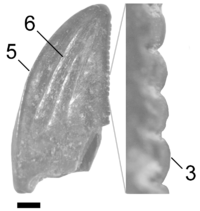 |
| Zephyrosaurus | 1980 | Cloverly Formation (Early Cretaceous, Aptian to Albian) | ( |
Currently only known from fragmentary remains but several undescribed specimens exist |  |
| Ziapelta | 2014 | Kirtland Formation (Late Cretaceous, Campanian) | ( |
Many specimens are known, most from the front part of the animal | 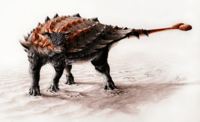 |
| Zuniceratops | 1998 | Moreno Hill Formation (Late Cretaceous, Turonian) | ( |
Carried a pair of brow horns despite not being a member of the Ceratopsidae | 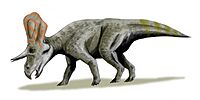 |
| Zuul | 2017 | Judith River Formation (Late Cretaceous, Campanian) | ( |
Preserves several osteoderms, keratin, and skin remains | 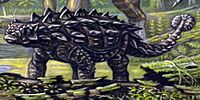 |
Invalid and Potentially Valid Genera
Some dinosaur names are not fully recognized or might be the same as other known dinosaurs. Here are a few examples:
- Agathaumas sylvestris: This dinosaur is famous from a painting by Charles Knight. It might be the same as Triceratops, but we can't be sure without more skull fossils.
- Alcovasaurus longispinus: First thought to be a type of Stegosaurus. It might actually be a species of Miragaia, which is mostly found in Europe.
- Antrodemus valens: This name might refer to the same dinosaur as Allosaurus. If so, Antrodemus would be the older, correct name. However, the fossils are not clear enough to confirm this.
- Apatodon mirus: Its first fossil was thought to be a pig jawbone! Later, it was identified as a dinosaur vertebra. We don't know what kind of dinosaur it was, but some think it might be from Allosaurus.
- "Capitalsaurus": This is the official dinosaur of Washington, D.C. It's known from a single vertebra found in a special place now called "Capitalsaurus Court."
- Cathetosaurus lewisi: Often considered a type of Camarasaurus. Some studies suggest it could be its own distinct genus.
- Deinodon horridus: Only known from teeth. Many teeth thought to be from Deinodon have been found to belong to other dinosaurs, and the original teeth might even be from Gorgosaurus.
- Dracorex hogwartsia: This dinosaur was named after Hogwarts from Harry Potter! It was described as a small, flat-headed pachycephalosaur. However, many scientists now think it's just a young Pachycephalosaurus.
- Drinker nisti: This name might be another name for Nanosaurus.
- Epanterias amplexus: Possibly a very large Allosaurus. It might be a different type of dinosaur because its fossils are from a slightly different time period.
- Latenivenatrix mcmasterae: This is the largest known troodontid. Some think it might be the same as Stenonychosaurus, which its fossils were originally assigned to.
- Mojoceratops perifania: This dinosaur might be a species or a specific type of Chasmosaurus.
- Nanotyrannus lancensis: Described as a small adult tyrannosaur. However, many scientists believe it's actually a young Tyrannosaurus rex.
- Nedoceratops hatcheri: This dinosaur was named "Diceratops" (meaning "two-horned face") because it lacked a nose horn. But it's likely just an unusual Triceratops specimen.
- Ojoceratops fowleri: This dinosaur might be an ancestor of Triceratops or even the same as Eotriceratops.
- Othnielia rex: Only known from a leg bone that doesn't give enough information to identify it clearly. It might have belonged to Nanosaurus.
- Othnielosaurus consors: Most likely another name for Nanosaurus.
- Protoavis texensis: This was described as a Triassic bird. However, it's probably a mix of bones from different, unrelated animals.
- Rubeosaurus ovatus: This is likely a species of Styracosaurus, or even just an unusual example of S. albertensis.
- Stygimoloch spinifer: This dinosaur had a short skull dome with long horns. Many think it's a young Pachycephalosaurus, but its fossils are found in slightly younger rock layers.
- Tatankaceratops sacrisonorum: This dinosaur has a strange mix of features from both young and adult Triceratops. It might be a smaller type of Triceratops or an individual that stopped growing early.
Images for kids
Timeline
This timeline shows when some of the dinosaurs from this list lived. Time is measured in Ma, which means millions of years ago.
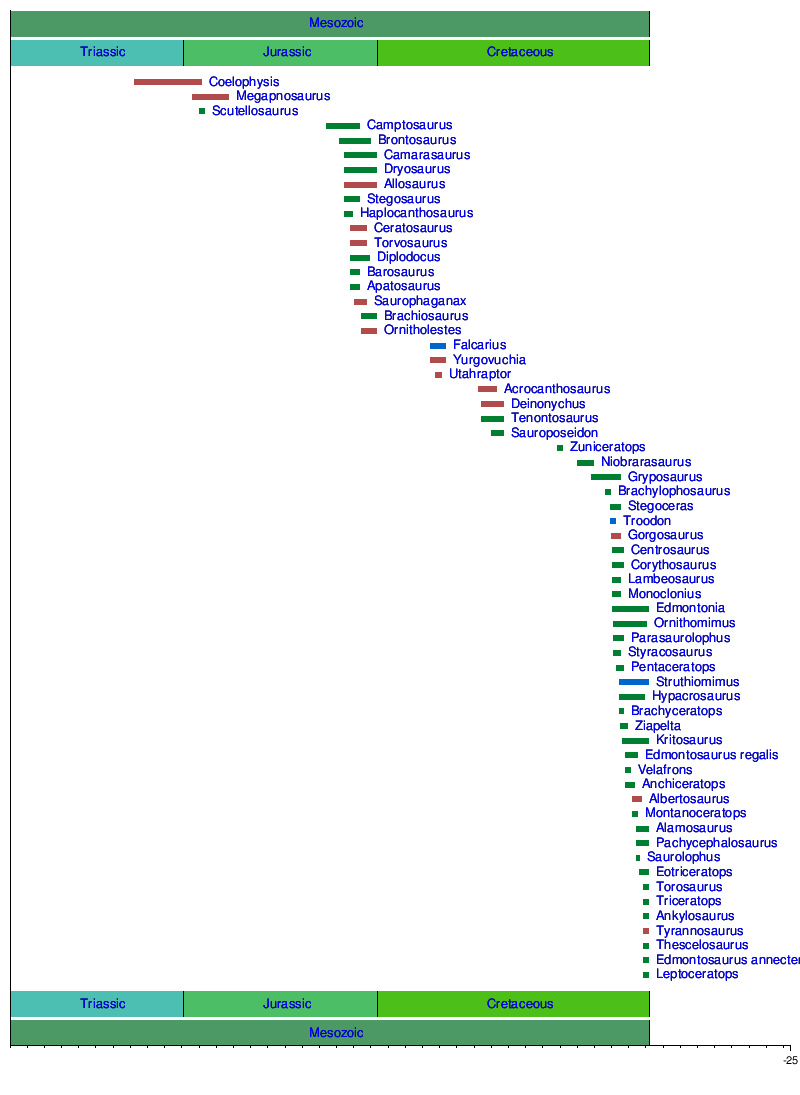
See also
- List of Appalachian dinosaurs - for dinosaurs specifically known from the former landmass of Appalachia (where much of eastern North America is now)
- List of North American birds





